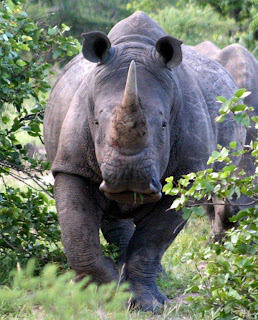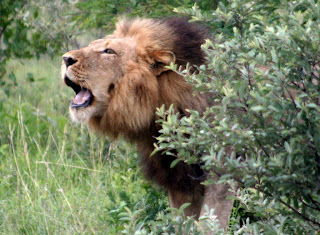.jpg)




High demand from
To learn more about rhino…read on
White rhino are the second largest land mammals on earth and as such enjoy a position amongst the ‘Big 5’ – historically those animals most dangerous to hunt but now the most sought after by tourists.
The shape of the lips led to the naming of this rhinoceros as Dutch settlers referred to the ‘wyd’ mouth (meaning wide) and colonialists misinterpreted this to mean white. The wide muzzle (20cm) comprises a more sensitive upper lip (which is used to manoeuvre grass clumps into the mouth) and a hard lower lip (against which the top lip presses to severe the grass). Both lips are swiped upwards to effect the neat cropping of grass. No incisors are involved at all in ingesting grass but broad, intricately enamelled molars inside the cheeks provide a grinding surface for mastication. A rhino crops the grass continuously moving its head in a semi-circle and then stepping forward to repeat the action. White rhinos maintain their own neatly cropped pastures in stands of favoured grass species (like Themeda triandra, Panicum maximum and Urochloa mossambicensis) which are often well concealed amongst taller grass. They rotate the use of their favourite feeding areas so as not to obliterate them. Rhinos practice geophagia (chewing of soil) to supplement minerals deficient in their all grass diet.
Because of the large quantity of fibrous grass that a rhino must consume to satisfy its energy requirements, it requires daily (if not twice daily) access to drinking water to assist with digestion. Rhino usually make their way to water late in the afternoon or even after dark. Because of their reliance on water, bulls that do not have a water source within their own territory will have to leave their turf and enter other bulls’ territories in order to drink. So long as an intruding rhino behaves submissively, territorial bulls will tolerate water-related visits from neighbours. A bull rhino shows its submission by urinating in a stream (on his own territory he would spray). He may also flatten his ears and squeal to reassure the territory owner of his innocuous intentions. If water is scarce, rhino can only go for up to four days without drinking.
White rhino are fond of wallowing in mud in order to help them cope with excessive summer heat conditions. A good caking of mud prevents sunburn and keeps a layer of moisture close to the skin to assist with keeping cool. The mud once dried also acts as a parasite-removing wax treatment that the rhino will rub free of their skin against trees, rocks or termite mounds. Rhinos are prone to reusing their rubbing posts that eventually become quite smooth and polished. They may also use these posts to scratch in hard to reach areas such as the inner legs and belly. While they wallow in the mud, terrapins will also pluck parasites off the rhino’s hide.
They have massive necks with a large nuchal hump over the shoulders. The thick albeit short neck supports the large head which is held low to the ground in order for the rhino to feed on the lowest-lying form of vegetation, grass. Having its head close to the ground also facilitates the use of its nostrils to detect olfactory (scent-related) clues regarding territory and the location of other rhino. Rhino rely on their sense of smell since eyesight is limited. The powerful neck also provides the force behind the defensive horns.
The most prominent feature of the rhino is its horns. These are weapons of defence used to protect itself and its offspring from predators or during bouts of combat. Horns are made of keratin (the same substance as fingernails) and grow 2-6 cm in a year and continue to grow throughout life. They are often worn down through usage and tend to be longer and thinner in cows which do not engage them as frequently as the bulls. The record horn length for a white rhino is 1.58m.
Rhino are active throughout both the day and night and spend at least half their time feeding in order to satisfy the nutritional demands of their huge bodies. They prefer to rest during the heat of the day which they will do under the cover of dense bush. They also take refuge in thickets should the weather turn particularly cold or windy. When they sleep they do so relatively soundly breathing heavily. During sleep the ears may be seen instinctively flicking in all directions and rhino can react to disturbing sounds with impressive speed if the need arises.
White rhino females are fairly gregarious (live with others of their own kind) and it is quite unusual to find a cow alone. A female is most often accompanied by her latest calf but sometimes the previous calf (who would have been chased off when the newest one arrived) will also accompany her. Cows without calves will often pair up and newly independent adults may form groups of the same (or even mixed) sexes of up to five individuals. Where there is good grazing or localized water, white rhino cows and their young may form aggregations sometimes numbering ten or more. Most of the time, female rhinos live in undefended home ranges that overlap with one another. Sometimes these home ranges can coincide with the territories of up to seven different bulls. Where there is abundant food and water, these ranges may be as small as 6km2 but may expand to 20km2 during dry and difficult seasons.
White rhino bulls are fiercely territorial and are always found alone unless courting a female. Although they mature at around four years old, bulls are not usually able to contend with other bulls for territories until they are twelve years old. So long as they demonstrate submissiveness to the older and larger territory holders, younger bulls are tolerated.
A bull rhino defends an area between 0.75 and 14km2 depending on the availability of resources. His territorial boundaries typically follow natural barriers like water courses, topographical ridges and even man-made roads.
To demarcate his territory a bull rhino employs a number of visual and olfactory signals. Patrols along well used paths take place to establish and reinforce boundaries. While patrolling, the bull will urine-spray backwards onto bushes and other conspicuous objects. Every 30m or so, the bull will also create visual scrape-markings with his feet that simultaneously become impregnated with his urine. As he continues his patrol, the scent is laid in the form of an olfactory (smell) trail wherever his feet touch. This is also achieved by kicking his dung with his hind feet after defecating. Intermittently along the territory boundaries, large accumulations of dung (known as middens) are formed and constantly added to by the bull and even by his neighbour. Cows (and subordinate bulls) will deposit their dung on a bull’s midden as and when they pass but refrain from breaking up their dung in the manner of the territorial bull. These sites provide important information to the territory owners such as when and who has passed through his turf.
When territorial bulls encounter one another along their boundaries, their responses are ritualized and posturing displays will satisfy one another of their independent statuses. However, when there is a new territory to claim or an oestrus cow in question, bulls will fight. Their primary weapons are their horns with which they will spar and attempt to hook one another. The skin over a rhino’s shoulders is 25mm thick to help reinforce this area against blows from opponents’ horns. Fights can be fatal.
Rhinos have relatively poor eyesight and can only really see well at close range. They do however respond to movement at greater distances. To compensate, the senses of hearing and smell are very well developed and both are employed for the purposes of communication and detecting danger. A rhino’s ears are constantly moving rotating independently in all directions to collect auditory clues. When a sound is detected, both ears focus in that direction. The ears are conveniently placed a top the long head to collect sounds while the low slung muzzle is optimally placed to smell.
The collective known for a group of rhino is appropriately ‘a crash of rhino’. Although they seem quite ungainly, rhino are able to charge at a speed of 40kmph if they need to. Rhinos that are stresses will perform displacement behaviour. This may take the form of curling up the tail, a nervous bouncy gait around the same spot, turning side on to the disturbance or rubbing the horn on the ground. Cows with young are especially protective. When a cow and her offspring flee from danger, the calf always runs ahead.
White rhinos differ from black rhinos in several ways. Black rhino are smaller than white rhino overall. They have shorter heads that are carried higher up on their shoulders than the white rhino to accommodate their browsing (not grazing) habits. The black rhino has a prehensile hook-shaped lip to help it secure leaves and twigs (compared to the wide mouth that the white rhino uses to graze). Twigs are cropped at a 45 degree angle due to the shape of the black rhino’s teeth and this angle is clearly identifiable in the twigs in their droppings. The ears of the black rhino are smaller and rounder and it lacks the large nuchal hump of the white rhino over the shoulders. The black rhino is one of






